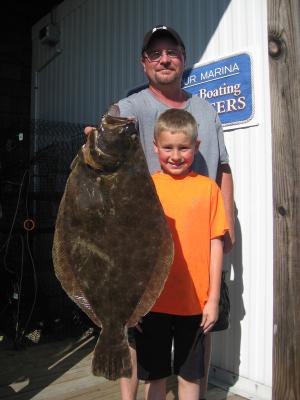Lewes man sets new state record for blueline tilefish
On June 19, William Fintel of Lewes went fishing on Capt. Ed Sigda’s boat the Snow Goose and returned from the canyons with the new Delaware state record blueline tilefish, a 19.7-pound beauty. Blueline tiles do not get as big a golden tiles, which can reach more than 50 pounds in weight. Both dwell in very deep water near the canyons, and cranking even a small one up from 600 feet or more is quite an accomplishment. The work is made easier by thoughts of how good these fish taste.
Fishing report
Croaker and flounder make up most of the catch in the Delaware Bay, Lewes and Rehoboth Canal, and the Broadkill River. Most of the croaker top the 8-inch minimum size with some exceeding 12 inches. The ratio of shorts to keepers for flounder is about two to one.
Targeting croaker is usually best right on top of bay structure at the reef sites. The Star Site (Site Eight) and Site Five in the Broadkill Slough have produced good catches from the bay. Croaker are spread out all over the Broadkill River and the canal, and if you find a concentration, short drift that area until the bite falls off.
Croaker have also been caught from shore at Town Park in Lewes and from Broadkill Beach. While these fish are generally not picky eaters, taking a dozen bloodworms on the trip will give you a much better chance of scoring.
Flounder are also on the reef sites, and the best results come by holding the boat directly over the structure and jigging with a bucktail or Tsunami ball jig. Bait with squid strips, shiners, Gulp! or live minnows. The same baits will work in the Broadkill River and the canal.
Some of the best flounder fishing has been in the ocean at the Old Grounds and Reef Site 11. Fish to over seven pounds have been caught by anglers working Delaware Bay Green Machines, Tsunami Ball jigs, bucktails, Gulp!, squid, fish strips and shiners. The bottom is pretty sticky in these locations, and successful anglers will lose a few rigs.
Indian River Inlet gave up more croaker in the past week to anglers fishing bloodworms or squid in the rocks. The best of the rockfish action comes after dark when sand fleas drifted in the rocks produce shorts and a few keepers. It seems the flounder have also taken up residence in and near the jetty. A live minnow allowed to swim free or a strip of squid on a bucktail have been the tickets for keeper flatfish.
Tuna have been active in the canyons. Bigeyes to well over 200 pounds have been caught by trollers working the late afternoon into the night. Yellowfins and dolphin have also been taken on the troll.
Summer striper season
The summer slot season for rockfish opened July 1 and will run until Aug. 31. The bag limit is two fish per day with a slot limit of 20 to 25 inches. The waters of the Delaware Bay and its tributaries including the Broadkill River and the Lewes and Rehoboth Canal are the only areas where this season is valid. All other Delaware waters and the New Jersey half of the Delaware Bay remain under the normal restrictions. The slot regulations stop at the Freeman Bridge in the Lewes and Rehoboth Canal.
Most of the slot stripers caught around Lewes will be taken from the Broadkill River and the canal. The bridges in Lewes and the marsh banks between the railroad bridge and the Savannah Road bridge have been good locations in the past. In fact, more than a few keeper rockfish have been caught here when the minimum size was 28 inches. Those fish are now illegal, but there should be slot fish available from now till Aug. 31.
Pencil eels are always a favorite for rockfish, as are live spot. Artificials that I have used with success include Rebel Wind Cheaters, small poppers and Gulp!. This year I want to try a few freshwater plugs made by Sebile. They look so much like small menhaden and shiners that I know they will work in the salt. I have removed the freshwater hooks and replaced them with saltwater trebles. In testing, the plugs look great, and I really do believe they will fool rockfish and blues.
The one thing every fishermen who targets rockfish knows is he or she will be losing some sleep. These fish feed best in low-light conditions, so being on the water well before dawn or staying out after dark is the most productive technique. Please be very careful when releasing striped bass of any size. Their survival rate goes down as the water temperature increases, and we want them to live a long life.
Eric Burnley is a Delaware native who has fished and hunted the state from an early age. Since 1978 he has written countless articles about hunting and fishing in Delaware and elsewhere along the Atlantic Coast. Eric can be reached at Eburnle@aol.com.





















































